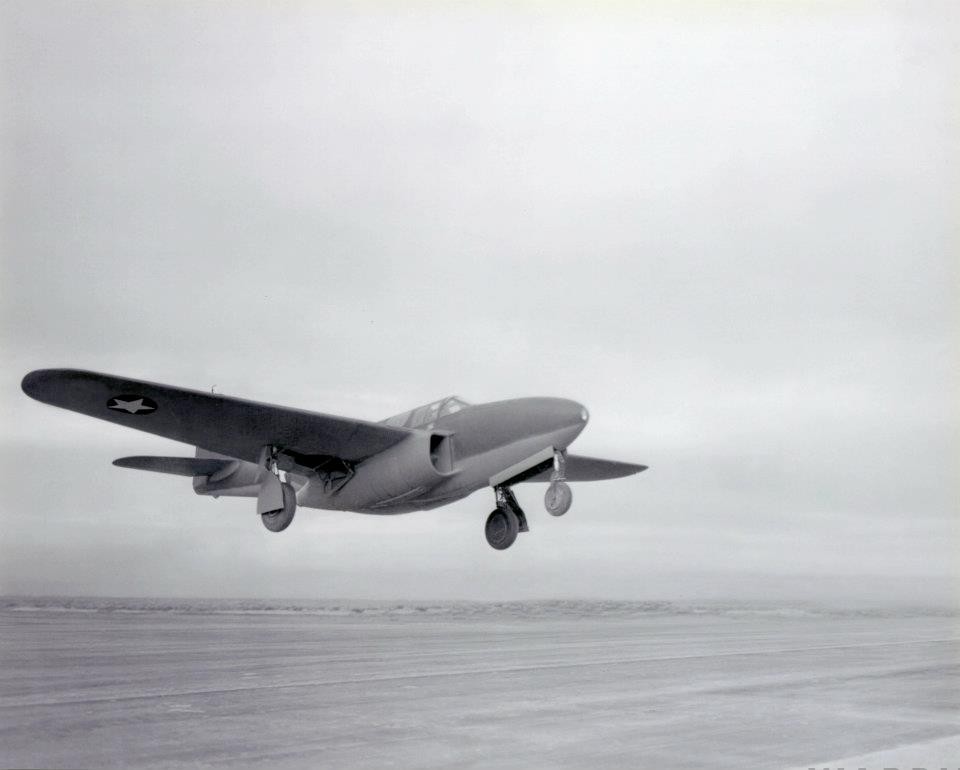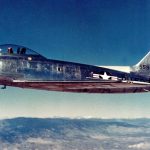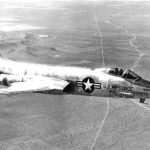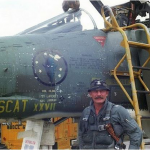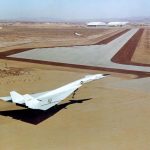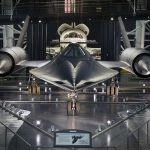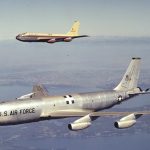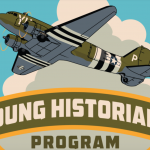by Bryan R. Swopes of This Day in Aviation
On October 1, 1942, at Muroc Dry Lake, in the high desert north of Los Angeles, California, Bell Aircraft Corporation’s Chief Test Pilot, Robert Morris Stanley, made the first flight of the top-secret prototype turbojet-powered fighter, the Bell XP-59A Airacomet, serial number 42-108784. The weather was “C.A.V.U.” (Ceiling and Visibility Unrestricted) and the wind was from the west at 20 miles per hour (9 meters per second).
In his report, Stanley wrote: “4. All take-offs were made using 15,000 r.p.m. on both engines with flaps fully up and with the airplane pulled off the ground at about 80 to 90 m.p.h. The throttle was applied promptly and acceleration during take-off appeared quite satisfactory. The run was estimated to be in the vicinity of 2,000 feet, possibly more. The first flight reached an altitude of approximately 25 feet, and landing was made using partial power without flaps. This take-off had the wind approximately 60° on the right bow and must be considered a cross-wind take-off.“
And “5. Aileron and elevator action appear satisfactory, although the rudder force appears undesirably light causing the airplane to yaw somewhat for very light pedal pressures. The left rudder was needed for take-off due to crosswind.” —Bell Aircraft Corp. Pilot’s Report 27-923-001, at Page 1-12, by Robert M. Stanley, 1 October 1942.
Stanley made three more flights that day, as high as 100 feet (30.5 meters). The following day, Army Air Corps test pilot Colonel Laurence C. Craigie conducted the “official” first flight, reaching an altitude of 10,000 feet (3,048 meters).
Three XP-59A prototypes were built. The number one ship, 42-108784, was affectionately nicknamed Miss Fire, because of the initial difficulty in getting the engines to start.
The Bell XP-59A was a conventional single-place airplane with the retractable tricycle landing gear. It was primarily of metal construction, though the control surfaces were fabric-covered. The prototype was 38 feet, 10 inches (11.836 meters) long with a wingspan of 49 feet, 0 inches (14.935 meters), and an overall height of 12 feet, 3¾ inches (3.753 meters), at rest. The leading edge of the wings was swept aft 7°. The angle of incidence was +2° with -2° twist and 2½° dihedral. The horizontal stabilizer had a span of 16 feet, 8 inches (5.080 meters). Its angle of incidence was +1½° with no dihedral. The vertical fin had 0° offset. The empty weight of the XP-59A was 7,319 pounds (3,320 kilograms) and its maximum gross weight was 10,089 pounds (4,576 kilograms).
The experimental fighter was initially powered by two General Electric Type I-A centrifugal reverse-flow turbojet engines, serial numbers 170121 (left) and 170131 (right), each producing 1,250 pounds of thrust (5.561 kilonewtons) at 15,000 r.p.m. These were copies of the British Whittle W.2B engines. They were heavy, underpowered, and unreliable.
Performance of the XP-59A was disappointing with a maximum speed of 350 miles per hour (563 kilometers per hour) at Sea Level and 389 miles per hour (626 kilometers per hour) at 35,160 feet (10,717 meters), significantly slower than many piston-engined fighters.
Three XP-59A prototypes and thirteen YP-59A preproduction airplanes were built. The P-59 was ordered into production and Bell Aircraft Corporation built thirty P-59A and twenty P-59B fighters. These were armed with one M4 37mm autocannon with 44 rounds of ammunition and three Browning AN-M2 .50-caliber machine guns with 200 rounds per gun.
Although a YP-59A had set an unofficial altitude record of 47,600 feet (14,508 meters), the Airacomet was so outclassed by standard production fighters that no more were ordered.
The race for a jet engine-powered fighter had been ongoing for several years, and the United States’ XP-59A was trailing behind. The first jet airplane, the Heinkel He 178, had made its first flight in Germany three years earlier, on 27 August 1939, though it was a proof-of-concept article, not an operational military aircraft. In the United Kingdom, the Gloster E/28.39, also a proof-of-concept aircraft, though more advanced than the Heinkel, made its first flight, 15 May 1941. The world’s first operational jet fighter, the Messerschmitt Me 262, made its first flight on 18 July 1942. It was nearly two years before production Me 262s entered combat, but they were devastating against bomber formations. The Gloster Meteor, the Allies’ first jet fighter, first flew 5 March 1943, and deliveries to fighter squadrons began in July 1944. The de Havilland DH.100 Vampire made its first flight 20 September 1943, but it did not become operational until after the end of World War II.
The XP-59A flew nearly five months before its British cousin, but would not be assigned to an operational squadron, the 445th Fighter Squadron, 412th Fighter Group, until June 1945.
The first American military jet aircraft, Bell XP-59A Airacomet 42-108784, was preserved by the Army at Muroc, and the engines at Wright Field, Ohio. In 1978, these were given to the Smithsonian Institution National Air and Space Museum where the prototype was later restored and placed on display.
For more aviation anniversaries please visit www.thisdayinaviation.com







